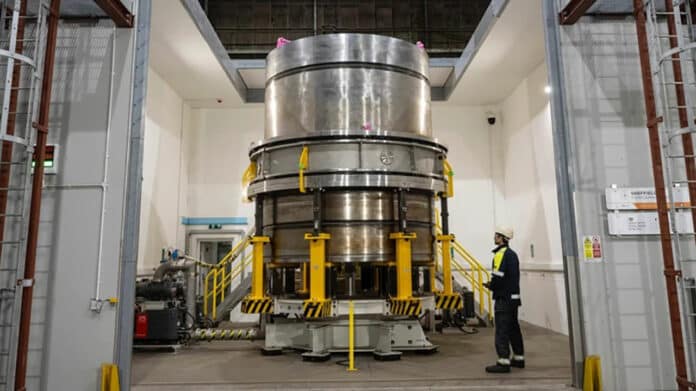UK company Sheffield Forgemasters has achieved a significant milestone in welding technology by completing the first full-sized Small Modular Reactor (SMR) nuclear vessel demonstrator assembly using Local Electron-Beam Welding (LEBW). This achievement marks a pivotal moment in global welding development.
The complete weld assembly of the vessel took less than 24 hours to complete four thick, nuclear-grade welds. Typically, such welds would require a year of work to complete.
Modular reactors have the potential to revolutionize the nuclear power industry by turning nuclear-generating plants from major civil engineering projects to factory-produced commodities. These reactors are smaller, scalable, have standardized designs, and can be installed in any number of locations that may not be suitable for larger nuclear power plants.
Since they don’t require the incredibly expensive buildings conventional reactors depend upon, the cost savings associated with modular reactors could be significant.
However, there are certain challenges associated with building reactors of any size. One of the major challenges is welding the vessels that are used to contain the reactor core.
To address this issue, Sheffield Forgemasters have come up with an innovative solution – Local Electron-Beam Welding (LEBW) – which can complete four thick, nuclear-grade welds in under a day. This is a significant improvement over conventional welding techniques that can take over a year to complete.
LEBW is a method of welding two pieces of metal together that uses a high-energy density fusion process. It involves a high-powered electron gun operating in a local vacuum, which can melt and fuse components together with high efficiency and deep penetration.
This technique has allowed Sheffield Forgemasters to complete a vessel with a diameter of three meters, a wall thickness of 200mm, and zero defects at a lower cost. The construction of the vessel showcases the reliability and capabilities of LEBW, setting a dramatic new standard for weld-joining thick-walled components.
The welding machine can also use innovative sloping-in and sloping-out techniques to start and finish the weld, ensuring a clean and complete weld join.
The demonstration of LEBW technology’s potential is expected to bring about more efficient, low-cost, and less time-consuming nuclear assemblies. The company responsible for this milestone is the only one in the UK with the capability to manufacture the large forgings required for SMRs. This demonstration also has far-reaching implications for other projects that require thick-walled welded assemblies.
“The implication of this technology within the nuclear industry is monumental, potentially taking high-cost welding processes out of the equation,” said Dr Michael Blackmore, Senior Development Engineer and Project lead. “Not only does this reduce the need for weld-inspections, because the weld-join replicates the parent material, but it could also dramatically speed up the roll-out of SMR reactors across the UK and beyond; that’s how disruptive the LEBW breakthrough is.”
